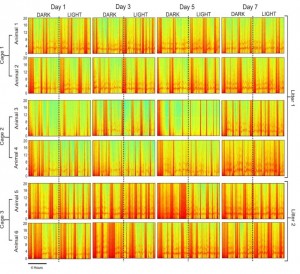A major bottleneck in behavioral research is understanding variability in experimental outcome. While an inevitable result of environmental and genetic interactions, inter- and intra-lab variability is frustratingly common and difficult to control. The human experimenter is a major source of variation in conventional behavioral experiments, but so are animal housing conditions. Differences in physical housing conditions are on the list of “questions that must be answered before using a behavioral battery” but rarely are1.
An animal’s physio-behavioral self reflects the continuous dynamical interaction of genetics with life history. A continuous record of the temporal dynamics in variables that define the physio-behavioral self may offer insight to the origins of inter-animal variability. Unfortunately, the present research enterprise is not positioned to assess continuous influence. First, separation of research testing from vivarium impedes such studies. As vivarium time greatly dominates an animal’s life history, the number of currently hidden variables that alter experimental outcome may be considerable. Second, the current technology for recording physiological variables in the home-cage are invasive and alter life history.
We have initiated steps aimed at attempting to understand the emergence of behavioral variability including in experimental outcome. Our primary objectives are to:
1. Pioneer use of affordable non-invasive bioelectric field sensors embedded within vivarium home cages to continuously capture recordings that constitute elements of an animal’s physio-behavioral self. Variables include respiratory rate, heart rate, and various movement related behaviors.
2. Use continuously captured physio-behavioral variables to assess emergence of inter-animal variability, and to identify metrics for automated quantification of variables that can be used to predict disease onset and in prevention.
Brown, R. E., Stanford, L. & Schellinck, H. M. Developing standardized behavioral tests for knockout and mutant mice. ILAR journal / National Research Council, Institute of Laboratory Animal Resources 41, 163-174 (2000).

